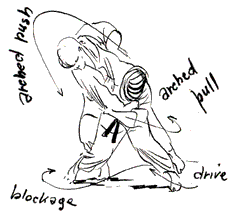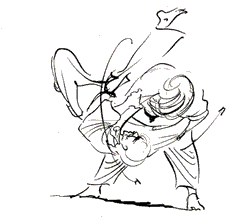Assalamualaikum!
At that time I had no idea what the repetitions meant, all that computed was "oh so boring" yet as time passed I finally embraced the crucial lesson: "If your opponent is off balance, you can lead him anywhere you want" or as my father would say "Kuda-kuda lemah, muka cium tanah"
In the world of martial arts no other system perhaps stresses the importance of drilling your opponent off balance than the grappling arts, such as Judo, Sambo, and Wrestling since these arts effectively use the clinch phase as a launching pad towards the opponents agonizing and disorientating doom through the use of hip, feet, shoulder or sacrifice throws.
So friends have a read, because when the situation counts and deescalating methods have failed let's make our best effort to have our opponents face and kiss the ground hard!
Wassalam!
-----------------------------
The Study of Kuzushi
By Neil Ohlenkamp
I was teaching my Judo class the other day, and I tried to explain the principal of kuzushi, or breaking balance. The reason I was explaining kuzushi is because during practice that evening most of the students were focusing on how to get their bodies into the proper position to apply the technique we were studying. Very little attention was being focused on placing the partner's body into the proper position. As I explained the importance of breaking the opponent's balance I could see that everyone understood that it is easier to knock down another person when he or she is off-balance. In fact I've noticed that is quite common for the principles of Judo to be understood long before they can be applied effectively. It is obvious, even to someone who has never studied Judo, that a throw will be more effective and require less strength when applied to an opponent who is in a weakened state of balance.
|
In this classical example of kuzushi being applied for the throw taiotoshi, tori's hands bring uke into a state of unbalance while tori remains in a strong, stable position ready to apply the throwing action.
From this position very little strength or energy is required for tori to complete the throw. Taiotoshi is classified by the Kodokan as a hand throw and it is easy to see how the hands pull uke off balance. Additional power is brought to the kuzushi during the pivoting action (taisabaki) as tori gets into position for the throw. |
One of the things that distinguishes a beginner from a more advanced student is the ability to focus attention on your opponent's balance. It is one of the differences between learning a throw, and being able to effectively apply a throw. Many martial artists tell me that they know how to do basic Judo throws like seoinage (one arm shoulder throw) or osotogari (leg outer reaping throw) for example. However, learning to get your body into the proper position to effectively apply your strength is only part of learning a Judo throw. The real trick to making Judo techniques work easily is to find a way to catch your opponent off-balance or to force your opponent off-balance.
Most people do a fine job of getting off-balance by themselves. One way to apply Judo throws is simply to catch the opponent at every opportunity that he or she gives you. It is just not possible to move without some degree of imbalance. It is certainly not easy for your opponent to attack you without a force and movement that makes him or her vulnerable to your counter attack. However learning to take advantage of your opponent's imbalance requires a finely tuned sense of timing. In order to be at the right place at the right time, you generally have to anticipate the opponent's movements, a skill that requires a great deal of experience.
Another way to apply kuzushi is to set up or force your opponent into a weak position. There are many ways of moving that will result in your opponent responding in a predictable way so that you can anticipate it and take advantage of it. It can be as simple as stepping forward and pushing on your opponent, which usually results in the opponent stepping back, bracing, and pushing back. This in turn gives you the opportunity to throw them forward in the direction of their push. The most common way to force your opponent off-balance is to use combination throws, where the first throw attempted puts the opponent into an unstable position so that a subsequent attack can be successful.
Kuzushi is very often thought of as simply pushing or pulling. At more advanced levels however it is much more than that. For example, kuzushi can also be achieved by breaking the opponent's rhythm, fake attacks, strikes, changes of body position or grip, kiai (a shout), or a sudden change in speed or tempo. A critical element in kuzushi is that it should disrupt more than the body. Kuzushi is very much a mental thing. Kuzushi should always disrupt the opponent's concentration, resulting in a momentary opportunity for an attack. This is one of the reasons confidence is such an important factor in Judo. A strong and positive mental attitude can often dominate a weaker state of mind, resulting in effective kuzushi.
Regardless of the physical size and strength of the opponent, kuzushi will always make a throw work more efficiently. Of course the same principle applies to any technique, including grappling techniques such as chokes and joint locks. Jigoro Kano, the founder of Judo, made the principle of kuzushi one of the fundamental elements of Judo, distinguishing it from old schools of jujitsu. The principle of kuzushi is still considered to be one of his major contributions to the study of martial arts. Don't neglect it in your study of Judo.


No comments:
Post a Comment